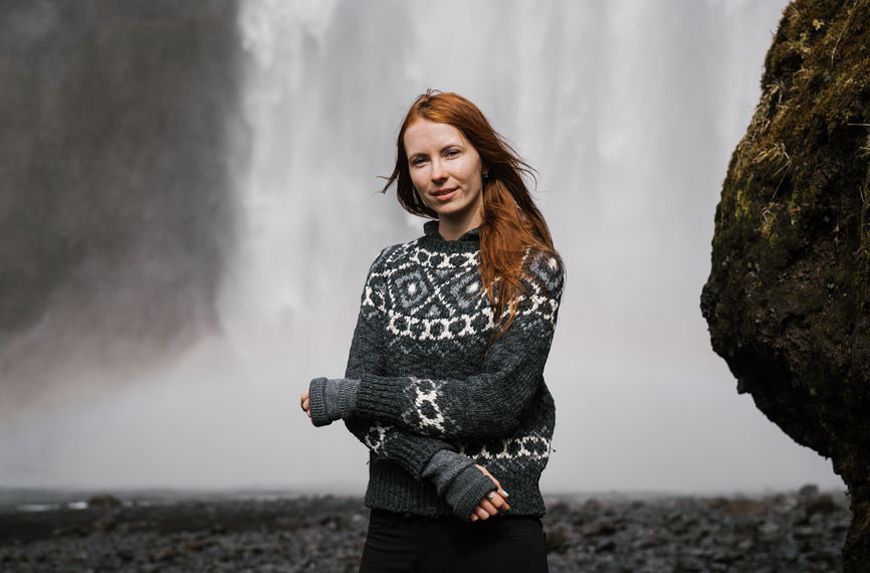If you want to know what's next in wellness, Susie Ellis is a *very* good person to ask. She's the chairwoman and CEO of Global Wellness Institute, the newest member of the Well+Good Council, and a woman with her finger on the pulse of trends. Now she's predicting that you'll be hearing a lot about happiness in the years to come: how to define it, how to cultivate it, and how to spread it. For her first Council story, she's sharing why she's betting on happiness—and her advice for finding more of it in your own life.
Every year, for 15 years, my research team and I identify the wellness trends we spot emerging for the year ahead. For the last two years, this report has been grounded in the many “aha” moments that come out of the annual Global Wellness Summit, where 600+ leading thinkers in wellness gather to discuss the future.
In an avalanche of fleeting wellness trends, these experts provide some rock-solid foundations for what new approaches will actually make a difference in people’s lives. But despite such bedrock, when our team gathers to select that year’s trends, there’s always heated debate. Voices rise; people strongly disagree. And that’s what happened this year when I argued for the “Happiness Meets Wellness” trend—predicting that the wellness world needs to (and will) put a much bigger focus on helping people get happier. My team complained, “Happiness is so vague. We don’t need more pressure to be happy.”

{{post.sponsorText}}
But I went to bat, stood firm, and prevailed. (Read the trend here.)
The surge in unhappiness is a crisis that’s hitting home hard.
I’m passionate about putting happiness at the very center of wellness for two powerful reasons. First, despite rising income-per-capita and life expectancy, the world remains unhappy. The 2018 World Happiness Report revealed that the average person rates their life a mediocre 5/10 on the happiness scale. Even in rich countries like the US and UK, we’re inundated with headlines on how depression, anxiety, addiction, and suicide have reached epidemic levels. This crisis took on a very public face recently with the shocking suicides of Kate Spade and Anthony Bourdain, but there were nearly 900 other Americans who killed themselves that same week—with the CDC recently reporting that suicide in the US has just reached a near 70-year high. We focus so intently on physical wellness, but the surge in unhappiness is a crisis that’s hitting home hard, and people need new (and more) pathways to mental well-being.
Secondly, happiness is a science. Since 2012, studies like the global World Happiness Report and US-focused Gallup-Sharecare Well-being Index take the annual pulse on which nations and US states are happiest and most miserable. Many countries, from Bhutan to Ecuador to Australia, are now making people’s happiness central to government policy. The UAE has even appointed a Minister of Happiness and the UK a Minister of Loneliness. One notable laggard: the United States. Despite the “pursuit of happiness” being key to our Declaration of Independence, we’re doing near nothing with happiness and policy.
These are four lessons from happiness science. Learn them and start to feel happier ASAP!

Happiness is about more than money or health
The World Happiness Report measures six key things to create a national happiness score:
- Income
- Healthy life expectancy
- Social connection/community
- Generosity
- Freedom
- Trust (absence of corruption in business/government)
What this, and a mountain of other research shows, is that while money and physical health are important factors in happiness, it’s social connections and community that plays the outsized role. Whether you’re a nation or a person, you can be wealthy, fit and unhappy, or poor, unhealthy and happy. It’s why countries like Mexico and Costa Rica often rank higher than rich, healthier ones; why the U.S. is seeing happiness take a serious dive (now ranked 18th worldwide); why people in China, despite incredible income gains, are no happier than they were 25 years ago. A Princeton University study showed that happiness increases as salaries rise to $75,000, after that, the happiness boost completely disappears.
In 2018, Northern European countries, as always, cleaned up as the happiest ones. The top five: Finland, Norway, Denmark, Iceland, and Switzerland. We need to study those cultures strong in social support, community, generosity, physical health/wellness, and honest governance.

Social connection: nothing matters more
When you digest the universe of happiness science, there is one overwhelming takeaway: human connection and a supportive community (with friends, family, colleagues, as a volunteer) have the biggest impact on both happiness and health. The Harvard Study of Adult Development concludes (after 70+ years of research) that it’s close relationships, more than fame, class, money, IQ, or even genes that keep people happy across their lives and delay mental and physical decline. But we have an isolation crisis (loneliness doubled in the US in the last 40 years) for so many reasons: from one quarter of Americans now living alone to a new gig/remote work economy to the sad fact that our idea of “social” is scrolling through our Instagram feed past all those (often falsely) smiling photos.
We simply have to spend more quality time with actual people, and a number of trends are helping make this happen. One is the surge in new co-working and social wellness spaces focused on building strong “hang out” communities, like women’s-only clubs that blend work, bonding, and wellness or all-gender coworking spaces.
We simply have to spend more quality time with actual people.
The new wellness real estate communities are fighting back against the decades-long “anti-social” bent in our homes and neighborhoods, which are actually designed to create isolation and keep you from your neighbors. At developments like Serenbe (Atlanta, Georgia) or Lake Nona (Orlando, Florida) building a true community is the mission–and they drive connections with programming around education and the arts.
There’s a boom in women’s-only adventure travel, where the key “wellness” served up is part physical challenge and part bonding with other fearless women–like tours from Adventure Travel, WHOA or Wild Women Expeditions.

Technology is making us unhappy
Studies are mounting on how constant digital connection, and designed-for-addiction smartphones and social media, are creating a depression and anxiety epidemic. The harmless-looking iPhone was born just a decade ago, and now we’re handcuffed to constant bad news, social media pressure, and work emails. We touch our phones 2,617 times each day and self-interrupt ourselves every 40 seconds, looking for that short-term reward-zap (two more “likes”) that works just like substance abuse. Every one of us feels the addiction, and how we can’t disconnect. It’s a moment that feels like the smoking issue was decades ago: a deep reluctance to believe the health impact that eventually gets overwhelmed by the evidence. And how tech affects happiness, thankfully, will be a new research focus of the World Happiness Report in 2019.
Helping people unplug will be a defining aspect of the future wellness movement.
Helping people unplug will be a defining aspect of the future wellness movement. It’s ironic, but the digital giants that invented these addictive platforms are making moves: Apple, Google, and Samsung are all launching tools that tackle tech addiction and set limits on screen time. Instagram has even created an entire well-being team to make the experience less unhappy. There’s an army of dedicated apps like Moment, Off the Grid and ThriveMode that help you set digital limits—even cutting you off cold when you binge.
In wellness travel, off-the-grid destinations focused on contemplation, community and nature are the most sought after. We named “silence” a top 2017 trend, noting the rise of completely silent spas, silent meals at wellness resorts, and totally silent retreats—like at Eremito, a “wellness monastery” in Umbria, with its silent candlelit dinners and 50-hour silent retreats. If you’re afraid of a day of silence and disconnection, just think of how bad your brain needs it.

Happiness grows in the gut
There’s eye-opening research on how our microbiome—that ecosystem of bacteria, fungi, viruses, and yeasts in our intestinal tract—plays a powerful role in determining our happiness. All those gut-bugs generate transmitters and hormones that play out within the brain, like serotonin that regulates mood, appetite, and sleep. Studies even suggest that the lion’s share of serotonin is produced in our gut, and disruptions in the microbiome are being connected to anxiety, depression, autism, and dementia. This study of the gut-brain-happiness axis is an exciting field called psychobiotics. For instance, a new study on rats found that injections of the bacteria Mycobacterium vaccae (a probiotic) led to higher levels of the anti-inflammatory protein interleukin-4 in the brain region that manages cognitive function, anxiety, and fear.
More people are now eating for a healthier microbiome: more fiber (like nuts and seeds) and probiotic/fermented foods (like yogurt, kombucha, kefir, sauerkraut, and kimchi). Foods like tuna, salmon, bananas, green tea, dark chocolate, spinach, and blueberries are also shown to boost serotonin and other happiness hormones. As the psychobiotic research marches on, the relationship between what we eat and our mental health will become clearer. We will eat for happiness.

Wellness is shifting to everyday life practices
When I think about big shifts happening in wellness, I see an expansion from products and treatments to a thirst for everyday life practices that make people meaningfully happier. As the Global Wellness Institute’s partner economist Thierry Malleret has argued, the issue is that people confuse pleasure or short-term reward with happiness, putting too much emphasis on hedonic wellbeing instead of the eudaimonic variety, which is about a meaningful life, contentment, and a sense of purpose. He argues we need to fight the fact that our brains now produce way too much dopamine—the “reward” neurotransmitter that makes us crave more instant self-gratification (whether via sugar, social media, or a “retail therapy” purchase). We need to produce more serotonin, the neurotransmitter for contentment, which dopamine drives down.
The current culture of wellness itself may be making us unhappy.
There has been a recent spate of articles about how the current culture of wellness itself may be making us unhappy. Any relentless quest for happiness and self-optimization, what The New Yorker has called our era of “improving ourselves to death,” is hardly a path to happiness—it’s an ego-driven pressure. In the future, the eudaimonic (or serotonin-driving) concept of well-being will become more important: less focus on self, and more focus on others and community.
It’s fascinating that of late people seem to be intuitively seeking the happiness philosophies from the happiest nations—whether it’s the Danish concept of hygge, creating cozy environments for close connection; or “lagom,” the Swedish all-in-moderation ethos of “not too much, not too little;” or the Japanese philosophy of “ikigai,” or finding a true life purpose and focusing on what you love. We need to study the happiest nations (not just how they tackle income inequality or provide affordable healthcare) but also their unique cultures of happiness and well-being.
We have a very serious happiness crisis. But what encourages me is that with a new body of happiness science, it’s no longer a frivolous concept, and it provides evidence about what can actually make us less unhappy. There’s no magic bullet, but happier people work at happiness. They work on close human connection, at disconnecting from technology and looking up from screens to experience life, at being physically active and eating well, and they practice optimism and gratitude. These are all life philosophies that cost very little.
Susie Ellis is the chairwoman and CEO of the Global Wellness Institute. She is also chairman and CEO of the Global Wellness Summit. Recognized as one of the leading authorities on the multi-sector wellness industry, she is frequently cited in major global publications.
What should Susie write about next? Send your questions and suggestions to experts@www.wellandgood.com.
Loading More Posts...